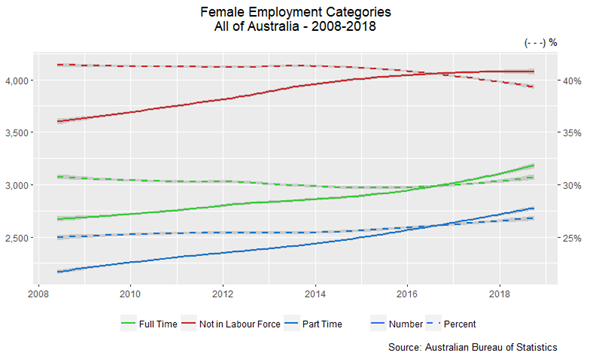Number of women in the workforce continues to increase
The number of women participating in the workforce continues to increase according to the latest employment data from the Australian Bureau of Statistics (ABS).

This has important implications for the demand for early education and care (ECEC) places as working families enrol their children in centres whilst attending work.
In addition, Child Care Subsidy (CCS) receipts are linked to an activity test which mandates specific activities that must be engaged in to qualify. Full and part time employment are on the qualifying activities list.
The percentage of women not in labour force (NILF) continues to drop consistently, while the number of women staying home appears to be plateauing. As the number of women aged 16 to 65 increases, a plateauing number NILF suggests a trend of women returning to work. This could suggest women are outsourcing more of the child care normally undertaken by them, or that a higher portion of the workforce with additional needs have been successful in gaining employment due to more inclusive workplace practices.
Over the past two to three years in particular, the percentage of work-age women in part or full time employment has been increasing slightly. This provides further evidence that a greater proportion of women are participating in the workforce. Prior to 2014, both the percentage of women in part or full time work, and the percentage of women NILF was relatively steady despite increasing population growth.
As the number of women in the workforce increases, the demand for childcare services also rises, as additional care is required for children who would otherwise be cared for at home. This increase in demand is likely to affect both children in long day care and older children requiring after school hours care.
The latest data also indicates that the trend unemployment for both males and females is at the lowest it has been since 2013, with just 680,000 work-age individuals across Australia unemployed, representing an unemployment rate of 5 per cent of the labour force
The next release of employment data is expected from the ABS on 20th December 2018.
Popular

Policy
Practice
Provider
Quality
NSW Government launches sweeping reforms to improve safety and transparency in early learning
2025-06-30 10:02:40
by Fiona Alston

Quality
Provider
Policy
Practice
WA approved provider fined $45,000 over bush excursion incident
2025-07-01 07:00:01
by Fiona Alston

Workforce
Policy
Quality
Practice
Provider
Research
ECEC must change now, our children can’t wait for another inquiry
2025-07-02 07:47:14
by Fiona Alston












